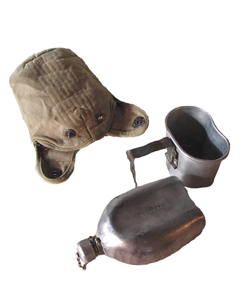M1910 CANTEEN, COVER AND CUP

M1910 canteens held one quart. A metal cup with folding handle fits onto the bottom of the canteen and the whole assembly slips into an wool felt insulated cover. Most all M1910 canteens will be marked with the manufacturers name and a date. Only the earliest production, pre W.W.I, seem to be unmarked. The cups are marked the same way on the handle for W.W.II production or on the outer bottom surface for W.W.I production. Several variations of this canteen exist. Look for the two types illustrated. Any W.W.I or W.W.II cup will fit any canteen. Make sure the canteen you buy is U.S. marked and dated before 1945 but donât waste your time trying to find a cup and canteen from the same manufacturer.
Figure #1 is actually a W.W.I canteen. It is aluminum. The two piece body, front and back, is welded together at and a metal mouthpiece is fitted to the top. An aluminum cap is connected to it with a chain made of sheet metal links. The chain and mouthpiece have a straw colored finish. There were such vast quantities of W.W.I equipment left over at the start of W.W.II that it was not uncommon to see this canteen being carried.
Figure #2 is W.W.II dated and made of two stainless steel stampings, top and bottom, welded together. It has a black plastic cap, U.S. marked, connected to the top of the canteen at a small stainless steel loop, spot welded to the behind and below the cap, with the usual sheet metal link chain. There are also aluminum canteens with W.W.II dates.
Figure #3 is the canteen cup of W.W.I made of heavy aluminum with a straw colored folding handle that flipped around the bottom when not in use. In W.W.II cups were also made of thin stainless steel, varying only in detail from the W.W.I type.
Covers will always be canvas with lift-a-dot fasteners. They are always lined with thin felt and equipped with the typical wire hanger at the back. They will usually be marked with the manufacturer and date under the flap or along the back bottom edge. Like the rest of the American web gear, they were dyed khaki initially but in 1943 khaki was dropped in favor of OD #7. Both dark green and khaki types were used together. Though our preference is with the khaki.